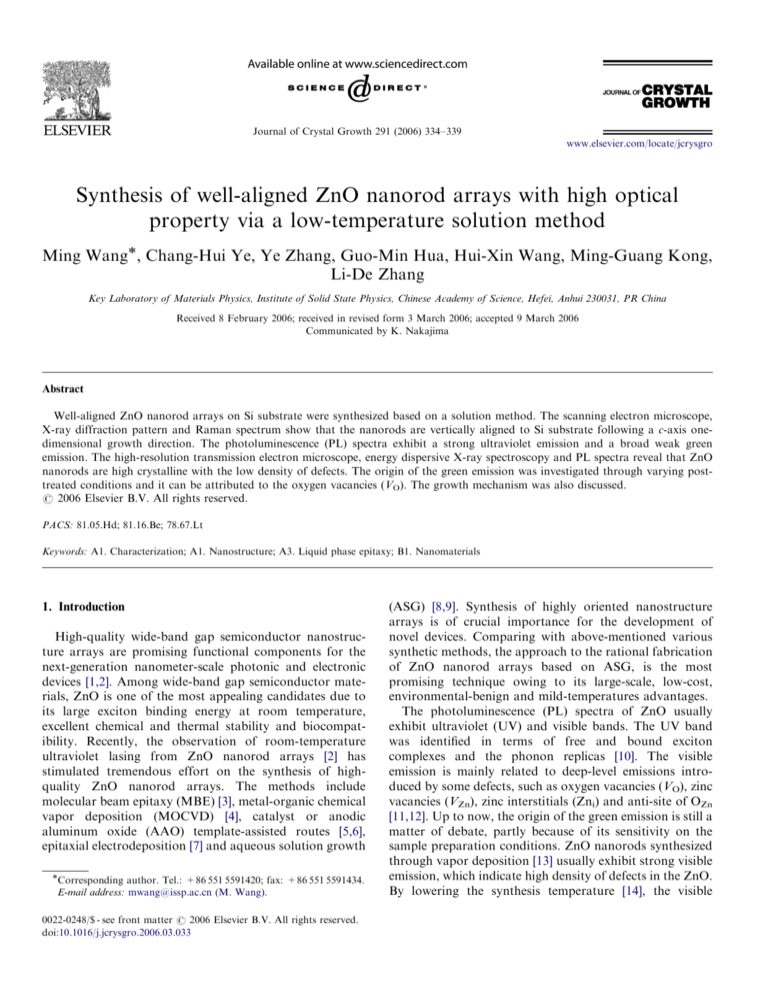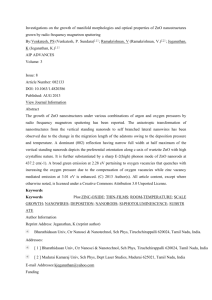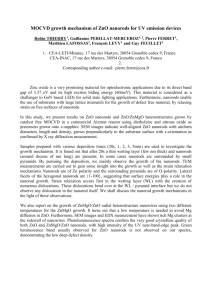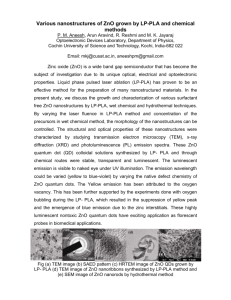
ARTICLE IN PRESS
Journal of Crystal Growth 291 (2006) 334–339
www.elsevier.com/locate/jcrysgro
Synthesis of well-aligned ZnO nanorod arrays with high optical
property via a low-temperature solution method
Ming Wang, Chang-Hui Ye, Ye Zhang, Guo-Min Hua, Hui-Xin Wang, Ming-Guang Kong,
Li-De Zhang
Key Laboratory of Materials Physics, Institute of Solid State Physics, Chinese Academy of Science, Hefei, Anhui 230031, PR China
Received 8 February 2006; received in revised form 3 March 2006; accepted 9 March 2006
Communicated by K. Nakajima
Abstract
Well-aligned ZnO nanorod arrays on Si substrate were synthesized based on a solution method. The scanning electron microscope,
X-ray diffraction pattern and Raman spectrum show that the nanorods are vertically aligned to Si substrate following a c-axis onedimensional growth direction. The photoluminescence (PL) spectra exhibit a strong ultraviolet emission and a broad weak green
emission. The high-resolution transmission electron microscope, energy dispersive X-ray spectroscopy and PL spectra reveal that ZnO
nanorods are high crystalline with the low density of defects. The origin of the green emission was investigated through varying posttreated conditions and it can be attributed to the oxygen vacancies (VO). The growth mechanism was also discussed.
r 2006 Elsevier B.V. All rights reserved.
PACS: 81.05.Hd; 81.16.Be; 78.67.Lt
Keywords: A1. Characterization; A1. Nanostructure; A3. Liquid phase epitaxy; B1. Nanomaterials
1. Introduction
High-quality wide-band gap semiconductor nanostructure arrays are promising functional components for the
next-generation nanometer-scale photonic and electronic
devices [1,2]. Among wide-band gap semiconductor materials, ZnO is one of the most appealing candidates due to
its large exciton binding energy at room temperature,
excellent chemical and thermal stability and biocompatibility. Recently, the observation of room-temperature
ultraviolet lasing from ZnO nanorod arrays [2] has
stimulated tremendous effort on the synthesis of highquality ZnO nanorod arrays. The methods include
molecular beam epitaxy (MBE) [3], metal-organic chemical
vapor deposition (MOCVD) [4], catalyst or anodic
aluminum oxide (AAO) template-assisted routes [5,6],
epitaxial electrodeposition [7] and aqueous solution growth
Corresponding author. Tel.: +86 551 5591420; fax: +86 551 5591434.
E-mail address: mwang@issp.ac.cn (M. Wang).
0022-0248/$ - see front matter r 2006 Elsevier B.V. All rights reserved.
doi:10.1016/j.jcrysgro.2006.03.033
(ASG) [8,9]. Synthesis of highly oriented nanostructure
arrays is of crucial importance for the development of
novel devices. Comparing with above-mentioned various
synthetic methods, the approach to the rational fabrication
of ZnO nanorod arrays based on ASG, is the most
promising technique owing to its large-scale, low-cost,
environmental-benign and mild-temperatures advantages.
The photoluminescence (PL) spectra of ZnO usually
exhibit ultraviolet (UV) and visible bands. The UV band
was identified in terms of free and bound exciton
complexes and the phonon replicas [10]. The visible
emission is mainly related to deep-level emissions introduced by some defects, such as oxygen vacancies (VO), zinc
vacancies (VZn), zinc interstitials (Zni) and anti-site of OZn
[11,12]. Up to now, the origin of the green emission is still a
matter of debate, partly because of its sensitivity on the
sample preparation conditions. ZnO nanorods synthesized
through vapor deposition [13] usually exhibit strong visible
emission, which indicate high density of defects in the ZnO.
By lowering the synthesis temperature [14], the visible
ARTICLE IN PRESS
M. Wang et al. / Journal of Crystal Growth 291 (2006) 334–339
emission band reduced. Thus the synthesis temperature
plays an important role in determining the optical property
of ZnO. However, in some previous reports [15,16], the
ZnO nanorods synthesized through low temperature
(below 100 1C) solution method exhibit strong defectrelated emission. This is difficult to explain from the
thermodynamic viewpoint. In this paper, we adopted the
well-established route reported in Ref. [15] to synthesise
well-aligned ZnO nanorod arrays grown on the Si
substrate. The PL result shows the ZnO nanorod arrays
possess high optical property with low density of defect.
The origin of the visible emission was also investigated.
2. Experiment
The fabrication procedure consists of two steps: (a)
preparation of seed-layer, (b) growth of nanorod arrays. In
the first step, 0.01 M as-prepared ZnO nanocrystals were
spin coated on the Si substrate for several times. ZnO
nanocrystals were prepared according to the previously
reported method [17]. Before coating, Si (1 0 0) wafers were
cleaned with acetone in an ultrasonic bath and etched by
piranha solution (2:1 mixture of concentrated H2SO4/
30%H2O2). And then, the seed-layer wafers were placed in
a sealed bottle containing of zinc nitrate hydrate
335
(0.01–0.1 M) and hexamethylenetetramine (0.01–0.1 M)
for 3–6 h at 75 1C. Finally the samples were rinsed with
deionized water for several times and dried at 60 1C for
several hours before characterization.
The structure and morphology were characterized by
means of X-ray diffraction pattern (XRD) (Philips X’Pert
Pro diffractometer with Cu KaRadiation), field-emission
scanning electron microscope (FE-SEM, FEI, Sirion),
high-resolution
transmission
electron
microscope
(HRTEM, JEOL-2010). The composition was determined
by energy dispersive X-ray spectroscopy (EDS, Inca
Oxford, attached to the FE-SEM). The PL (excited with
the 325 nm He–Cd laser) and Raman spectra (excited with
the 514.5 nm Ar+ laser) were recorded by the LABRAMHR spectrometer (Jobin–Yvon). The seed-layer surface
was observed by atomic force microscopy.
3. Results and discussion
3.1. Structure and morphology
Fig. 1 shows scanning electron microscope (SEM)
images of the ZnO nanorod arrays grown on Si substrate.
The low-magnification image shows a large area uniform
film-like material deposited on the substrate (Fig. 1(a)).
Fig. 1. FE-SEM images of the well-aligned ZnO nanorod arrays on Si wafer. (a) Large-scale and low magnification, (b) and (c) fine structure of the
nanorods under high magnification, (d) cross-sectional view.
ARTICLE IN PRESS
336
M. Wang et al. / Journal of Crystal Growth 291 (2006) 334–339
From the high-magnification images (Figs. 1(b) and (c)), it
can be seen that a high density of ZnO nanorods with welldefined hexagonal facets (0 0 1) were grown vertically on
the substrate. The nanorods have a narrow size distribution
centered at about 100 nm in diameter. The cross-sectional
view (Fig. 1(d)) of the nanorod arrays demonstrated that
the ZnO nanorods grew vertically with identical length
about 1.2 mm. The diameters and length of the nanorods
can be tailored by controlling the growth parameters such
as growth time, temperature, and zinc salt concentration.
Fig. 2(a) shows the corresponding XRD pattern of the
ZnO nanorod arrays grown on the Si substrate. The
intensity of the (0 0 2) peak is very strong compared with
that of the other peaks such as (1 0 0) and (1 1 0). The result
indicates the ZnO nanorod arrays are highly aligned
perpendicular to the Si substrate with c-axial growth
direction. The individual single nanorod was characterized
using a high-resolution transmission electron microscopy
(HRTEM). The images illustrate that the ZnO nanorod has
high-quality single-crystal structure with smooth surface
and follows [0 0 1] growth direction (Fig. 2(b)). This result
is consistent with that confirmed by SEM images and XRD
pattern. The corresponding selected area electron diffraction further proves the single-crystalline property of ZnO
nanorod and their [0 0 1] growth direction (inset of
Fig. 2(b)). Fig. 2(c) shows the chemical composition of
the nanorods determined by EDS. Only oxygen, zinc,
and silicon were detected. The silicon element comes from
the substrate. This confirms that the nanorods are
primarily ZnO.
3.2. Raman spectrum
Raman scattering is an effective method to investigate
the crystallization, structure and defects in the nanostructure materials. Wurtzite ZnO belongs to the C 46v space
group with two formula units per primitive cell. Based on
the group theory analysis, at the G point of the Brillouin
zone, the A1+E1+2E2 modes are Raman active [18]. In
this experiment, the incident light is normal to the
substrate, namely, the incident light is parallel to the
c-axis of the nanorods and the Raman signal was recorded
in the backscattering geometry. In this configuration, only
A1 (LO) and E2 modes are allowed and the other modes are
forbidden according to the Raman selection rules [19,20].
The Raman spectrum of the ZnO nanorod arrays was
shown in Fig. 3. As expected, only the E2 (high) mode at
438 cm1 and A1 (LO) mode at 575 cm1 were observed,
which further confirms that the ZnO nanorod arrays are
highly c-axis oriented. The peaks at 301, 520 and 617 cm1
originate from the Si substrate.
3.3. PL spectra
The optical properties of the ZnO nanorods were
investigated by PL spectroscopy excited with the 325 nm
He–Cd laser. The exciting power intensity was about
Fig. 2. (a) XRD pattern of the ZnO nanorod arrays, (b) HRTEM image
of a single ZnO nanorod and the corresponding selected area electron
diffraction pattern (inset), (c) Energy dispersed X-ray spectroscopy (EDS)
of the ZnO nanorod arrays.
2 kW cm2. Fig. 4 show the room-temperature PL spectra
of the as-grown sample and the post-treated samples. A
dominant emission peak is observed at about 380 nm for
the three samples, which can be attributed to the
recombination of the free excitons or the near band edge
emission of the wide band-gap ZnO [3,21]. Obviously, after
being annealed in air (line b) and in hydrogen ambient (line
c), the intensity of the UV emission increased and its peak
position red shifted from 375 to 385 nm, which indicates
ARTICLE IN PRESS
M. Wang et al. / Journal of Crystal Growth 291 (2006) 334–339
337
assignment, we annealed the sample in the hydrogen
ambient. As shown in line c, the green band is a little
increased. This result is consistent with the finding reported
by Cocivera [25] that the oxygen vacancies increase under
reductive annealing gas.
To distinguish PL bands caused by zinc interstitials (Zni)
and oxygen vacancies (VO) in experiments are usually
difficult. Recently, Kohan et al. [26] and Van de Walle [27]
calculated the formation energies and electronic structure
of native point defects in ZnO theoretically. The concentration of defects in a crystal depends upon its formation
energy Ef in the following form:
Ef
c ¼ N sites exp ,
(1)
kB T
Fig. 3. Raman spectrum of the ZnO nanorod arrays grown on the Si
substrate.
where Nsites stand for the concentration of sites where the
defects can occupied. Ef is related to chemical potentials of
zinc, oxygen and zinc oxide which depend on the growth
conditions. The formation energy of a point defect in a
charge state q can be described as:
E f ðqÞ ¼ E tot ðqÞ nZn mZn nO mO qE F ,
(2)
tot
Fig. 4. Room temperature PL spectra of the ZnO nanorod arrays of the
as-grown and post-treated samples.
that the annealing treatment reduces the nonradiative
action and improves the crystal quality of the nanorods
[22]. Furthermore, the full-width at half-maximum
(FWHM) of the UV emission is estimated to be 110 meV,
a little smaller than the value (120 meV) obtained from
other synthesis methods [23,24]. This narrow FWHM
indicates the high crystal quality of the ZnO naorod arrays
with narrow size distribution. In addition to the UV
emission, a weak and broad emission centered at 530 nm
also can be observed from the as-grown sample. After
annealing in the air at 500 1C for half an hour, this peak
completely disappeared, which indicate that the defects in
the ZnO are low and can be eliminated easily by a simple
heat treatment. The green emission can be attributed to the
VO and Zni in the ZnO nanorods. In order to confirm this
where E (q) means the total energy of a system containing
nZn and nO zinc and oxygen atoms, mZn and mo are the
chemical potentials for zinc and oxygen, and EF is the
Fermi energy. Their calculation result shows that oxygen
and zinc vacancies are the two most common defects in
ZnO. In zinc-rich conditions, the oxygen vacancies (VO)
have lower formation energy (1.2 eV) than the zinc
interstitials (Zni) and will dominate in the defect, and in
oxygen-rich conditions, zinc vacancies (VZn) should dominate. In this aqueous growth condition, Zn comes from the
zinc salts and the O comes from the OH. This aqueous
system can be classified as Zn-rich conditions due to the
high solubility of the zinc salts. Therefore, deduced from
our PL spectra result, only the low density of oxygen
vacancies (VO) is responsible for the green emission. The
zinc interstitials (Zni) and zinc vacancies (VZn) could
be excluded in our samples. Otherwise, from the above
Eq. (1), the growth temperature also plays an important
role in determining the concentration of defects. Comparing the synthesis temperature in our experiments with the
vapor transportation deposition, the defect concentration
should be reduced. Our PL results are consistent with the
thermodynamic principles. The low growth temperature
results in strong UV emission and weak green emission
owing to the low density of defects in the ZnO nanorods.
3.4. Growth mechanism
The growth of oxide nanorods from aqueous solution
involves controlled heterogenous nucleation and homogeneous nucleation on the substrate [28]. In this chemical
solution, the hexamethylenetetramine decomposed to
formaldehyde and ammonia, which act as a pH buffer to
regulate the pH value of the solution and supply of OHslowly [29,30]. Through the whole experiment, the pH
ARTICLE IN PRESS
M. Wang et al. / Journal of Crystal Growth 291 (2006) 334–339
338
value keeps about 6–7. The main chemical process can be
described as
ðCH2 Þ6 N4 þ 6H2 O ! 6HCHO þ 4NH3 ,
(3)
NH3 þ H2 O ! NHþ
4 þ OH ,
(4)
2OH þ Zn2þ ! ZnðOHÞ2 ,
(5)
ZnðOHÞ2 ! ZnO þ H2 O:
(6)
The most stable crystal of ZnO is wurtzite structure
consisting of polar (0 0 01), (0 0 01̄) planes and non-polar
(1 0 0 0) planes with C6v symmetry. Due to its anisotropic
crystal structure, the c-axis is the most preferred growth
orientation, and the velocities of growth under hydrothermal conditions are V [0 0 01]4V [0 1 1 0]4V [1 0 0 0]
[31]. Because of the polar nature of positively or negatively
charged ZnO surface, the surface attracted opposite
charged ions on it and reacted to form ZnO nanorods
owing to its anisotropic growth character [32]. The
undercoat of ZnO nanoparticles on the substrate plays an
very important role in achieving high density of uniform
ZnO nanorods arrays. The ZnO nanocrystals on the
substrate were observed by atomic force microscopy. As
shown in Fig. 5, a very uniform nanocrystals adhering to
the substrate can be observed, which served as the
nucleation centers. Without the seed layer, there are
seldom nanorods randomly distributed on the bared
substrate (see Fig. 6(a)). In the growth process, we find
the solution became turbid after 1 h. The initial growth
stage plays a very important role in obtaining the high
quality of ZnO nanorod arrays. From the thermodynamic
view, the heterogeneous nucleation is more favorable than
homogeneous nucleation due to its low supersaturation.
Thus the whole growth process can be divided into two
parts: the hetero geneous nucleation-dominant and the
Fig. 6. FE-SEM images of (a) nanorods grown on bare Si substrate, (b)
nanorods obtained from the seed-coated Si substrate when it was put into
the bottle after the solution became turbid.
homogeneous nucleation dominant process. Aim to test
this assignment, the seed-coated substrate was put into the
bottle after the solution became turbid. As shown in Fig.
6(b), the ZnO nanorods are large and just randomly
distributed on the substrate. This shows that the nanorods
are formed through the homogeneous nucleation. The
growth time, concentration and temperature just only
affect the ZnO nanorod size and length.
4. Conclusion
Fig. 5. AFM image of the seed-coated Si substrate.
In summary, well-aligned ZnO nanorod arrays can be
produced through a simple route based on the ASG
approach. The nanorod arrays are highly c-axis oriented
and perpendicular to the substrate with high crystalline
quality. These samples exhibit strong UV emission and
weak broad green emission, which indicate the high optical
quality of the ZnO nanorod arrays with low density of
ARTICLE IN PRESS
M. Wang et al. / Journal of Crystal Growth 291 (2006) 334–339
defects. The defect-related green emission was studied by
varying the annealing conditions. The green emission is
attributed to the oxygen vacancies (VO) in the ZnO
nanorods. The initial growth stage is very important in
achieving the high density of ZnO nanorod arrays. These
ZnO nanorod arrays have good potential application in
photoelectric devices.
Acknowledgments
This work was supported by Major Research Plan of
National Natural Science Foundation of China (Grant no.
90406008) and National Major Fundamental Project:
Nanomaterials and Nanostructures (Grant no. 2005CB623603).
References
[1] Z.L. Wang, J. Phys.: Condens. Matter. 16 (2004) R829.
[2] M.H. Huang, S. Mao, H. Feick, H. Yan, Y. Wu, H. Kind, E. Weber,
R. Russo, P. Yang, Science 292 (2001) 1897.
[3] Y. Segawa, A. Ohtomo, M. Kawasaki, H. Koinuma, Z.K. Tang,
P. Yu, G.K.L. Wong, Phys. Status Solidi b 202 (1997) 669.
[4] W.I. Park, D.H. Kim, S.W. Jung, G.C. Yi, Appl. Phys. Lett. 80
(2002) 4232.
[5] M.H. Huang, S. Mao, H. Feick, H. Yan, E. Weber, P. Yang, Adv.
Mater. 13 (2001) 113.
[6] Y. Li, G.W. Meng, L.D. Zhang, F. Phillipp, Appl. Phys. Lett. 76
(2000) 2011.
[7] R. Liu, A.A. Vertegel, E.W. Bohannan, T.A. Sorenson, J.A. Switzer,
Chem. Mater. 13 (2001) 508.
[8] L. Vayssieres, Adv. Mater. 15 (2003) 464.
[9] Z.R. Tian, J.A. Voigt, J. Liu, B. Mckenzie, M.J. Mcdermott,
M.A. Rodriguez, H. Konishi, H.F. Xu, Nat. Mater. 2 (2003) 821.
[10] S.A. Studenikin, M. Cocivera, W. Kellner, H. Pascher, J. Lumin. 91
(2000) 223.
339
[11] K. Vanheusden, W.L. Warren, C.H. Seager, D.R. Tallant, J.A. Voigt,
B.E. Gnade, J. Appl. Phys. 79 (1996) 7983.
[12] Y.F. Chen, D.M. Bagnall, H.J. Koh, K.T. Park, K. Hiraga, Z.Q.
Zhu, T. Yao, J. Appl. Phys. 84 (1998) 3912.
[13] V.A.L. Roy, A.B. Djurisic, W.K. Chan, J. Gao, H.F. Lui, C. Surya,
Appl. Phys. Lett. 83 (2003) 141.
[14] J.J. Wu, S.C. Liu, Adv. Mater. 14 (2002) 215.
[15] L.E. Greene, M. Law, J. Goldberger, F. Kim, J.C. Johnson,
Y. Zhang, R.J. Saykall, P. Yang, Angew. Chem. Int. Ed. 42 (2003)
3031.
[16] Q. Tang, W. Zhou, J. Shen, W. Zhang, L. Kong, Y. Qian, Chem.
Commun. (2004) 712.
[17] L. Spanhel, M.A. Anderson, J. Am. Chem. Soc. 113 (1991) 1511.
[18] C.A. Arguello, D.L. Rousseau, S.P.S. Porto, Phys. Rev. 181 (1969)
1351.
[19] A. Kaschner, U. Haboeck, M. Strassburg, M. Strassburg,
G. Kaczmarczyk, A. Hoffmann, C. Thomsen, A. Zeuner, H.R.
Alves, D.M. Hofmann, B.K. Meyer, Appl. Phys. Lett. 80 (2002) 1909.
[20] T.C. Damen, S.P.S. Porto, B. Tell, Phys. Rev. 142 (1966) 570.
[21] J.J. Wu, S.C. Liu, Adv. Mater. 14 (2002) 215.
[22] S.T. Tan, B.J. Chen, X.W. Sun, W.J. Fan, H.S. Kwok, X.H. Zhang,
S.J. Chua, J. Appl. Phys. 98 (2005) 013505.
[23] J.S. Jie, G.Z. Wang, Q.T. Wang, Y.M. Chen, X.H. Han, X.P. Wang,
J.G. Hou, J. Phys. Chem. B 108 (2004) 11976.
[24] C. Geng, Y. Jiang, Y. Yao, X. Meng, J.A. Zapien, C.S. Lee,
Y. Lifshitz, S.T. Lee, Adv. Funct. Mater. 14 (2004) 589.
[25] S.A. Studenikin, N. Golego, M. Cocivera, J. Appl. Phys. 84 (1998)
2287.
[26] A.F. Kohan, G. Ceder, D. Morgan, C.G. Van de Walle, Phys. Rev. B
61 (2000) 15019.
[27] C.G. Van de Walle, Physica B 308–310 (2001) 899.
[28] L. Vayssieres, K. Keis, S.-E. Lindquist, A. Hagfeldt, J. Phys. Chem. B
105 (2001) 3350.
[29] J.G. Strom Jr., H.W. Jun, J. Pharm. Sci. 69 (1980) 1261.
[30] K. Govender, D.S. Boyle, P.B. Kenway, P.O. Brien, J . Mater . Chem
. 14 (2004) 2575.
[31] R.A. Laudise, A.A. Ballman, J. Phys. Chem. B 64 (1960) 688.
[32] Z.L. Wang, X.Y. Kong, Y. Ding, P. Gao, W.L. Hughes, R. Yang,
Y. Zhang, Adv. Funct. Mater. 14 (2004) 943.






